Solid-State NMR Methodology
Magic-Angle Spinning (MAS)
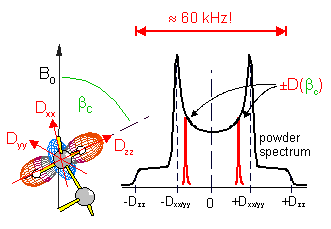
The most important aspect in solid-state NMR is the dominance of orientation-dependent interactions, which are usually averaged out in NMR spectra of solutions. They lead to substantial broadening of the spectra and a loss of spectral resolution.
High resolution can be re-gained by rapid sample rotation about the magic angle (54.7°), which, much like in the case of solutions, effectively averages all orientation-dependent interactions.
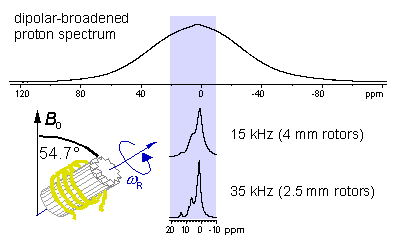
While almost liquid-like resolution is achievable for 13C already at moderate spinning frequencies, very-fast MAS in excess of 25 kHz is needed in order to narrow dipolar-broadenend proton spectra. This is due to the strong multi-spin dipolar-coupling network among the abundant protons, which is also responsible for the smearing of the typical features of powder (Pake) spectra in the static limit.
Dipolar Couplings and Internuclear Distances

Dipolar coupling constants are dependent on the distance between the coupled spins. Yet, their measurement is precluded when MAS is applied, because this valuable information is simply averaged away. The solution to this paradox is the application of recoupling pulse sequences of a specific duration as part of a two- or higher dimensional experiment. The variation of the recoupling time while monitoring the signal intensity provides access to the dipolar coupling. The experiment might embody the temporary excitation of higher-quantum coherences. A special variant of this approach comprises a second Fourier transformation over an indirect time domain, which leads to the appearance of coupling-specific sideband patterns.
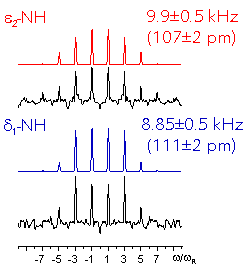
The spectra shown here are special in that they were obtained on samples naturally abundant in 15N (!) by using inverse detection. I.e., the detection of the signal takes place on protons instead of the weakly sensitive heteronucleus.
The distances which are extracted from the spinning sideband patterns are in good agreement with results from other methods. In fact, only neutron scattering or X-ray scattering involving substantial refinement is able to provide distance information with comparable accuracy.
Proton Multiple-Quantum Spectroscopy
The measurement of inter-proton dipolar couplings is particular attractive in that it provides information on dynamics in polymers, and has the advantage of being applicable to as-synthesized samples. Polymers, and other soft matter, are, unlike normal liquids, characterized by anisotropic molecular motions. This leads to the appearance of weak, residual dipolar couplings, which is proportional to the order parameter of the polymer chain. This order parameter provides a link to macroscopic (e.g mechanical) properties, and can be used to put theories of polymer dynamics to a test.
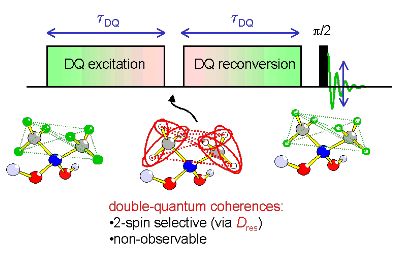
While line shape analysis might not be very reliable, due to the problem of multiply coupled spins and featureless spectra, multiple-quantum spectroscopy is able to provide faithful information. The technique resembles the recoupling experiments mentioned above, but can also be applied in static samples. Information on dipolar couplings is extracted by observing the signal intensity as a function of the duration of a double-quantum pulse sequence.
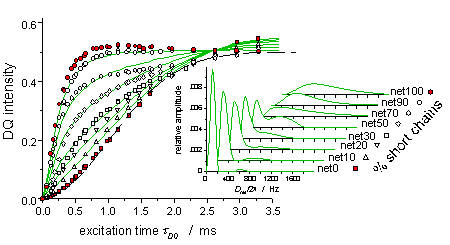
We have developed an experimental strategy, with which it is possible to not only determine the amount of liquid-like components and the average order parameter in a given network sample, but also to characterize the order parameter distribution. The method was tested on a series of bimodal network samples, which were obtained by end-linking mixtures of short and long precursor polymers.
Exchange Spectroscopy under MAS
The centerband-only detection of exchange (CODEX) experiment, recently introduced by Schmidt-Rohr et al., is a powerful MAS method which allows the elucidation of molecular rotations on the ms to s time scale. It probes reorientations of the chemical-shift anisotropy tensor of 13C or other heteronuclei by means of recoupling. It is convenient in that exchange is detected by the appearance of signals in highly resolved MAS spectra.

From the variation of signal intensities as a function of the mixing time, tm, or the recoupling time, NrτR, it is possible to obtain the correlation time of the slow process, tc, and the jump angle, respectively.
The long-time intensity plateau is further dependent on the number of sites accessible to the jump motion. A decrease of this plateau intensity at higher temperatures is indicative of short correlation times reaching the experimental time scale (intermediate motional regime).

We have made extensive use of the CODEX technique in our investigations of polyphenylene dendrimers, where we could identify a rather peculiar small-angle phenyl flip by about 24°. As is seen in the figure, it is even possible to obtain information on the imprecision of the jump.



